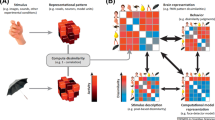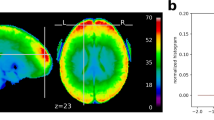Abstract
The sharing of primary data in the field of neuroscience has received considerable scrutiny from scientific societies and from science journals. Many see this as value added for science publishing that can enhance and inform secondary examination of data and results. Still others worry that data sharing is an undue burden for researchers with little long term value to science. But examples of how data sharing can be done successfully do exist. The fMRI Data Center, established at Dartmouth College in 2000 and now based at the University of California Santa Barbara, has worked to facilitate the open sharing of neuroimaging data from peer-reviewed papers to foster progress in cognitive science. The fMRI study on the representation of objects in the human occipital and temporal cortex, published in 2000 in the Journal of Cognitive Neuroscience (JOCN), marked the first deposition in the new database. Despite initial concerns about fMRI data sharing, this data set was frequently downloaded. We describe the original results of distributed brain activation patterns elicited by faces and objects in the human visual system, and overview several secondary analyses by independent investigators. A philosopher tested Husserl’s temporal components of consciousness, whereas other brain imagers deployed new analytic tools, from Dynamic Causal Modeling, which estimates the neural interactions between cortical regions, to a novel method for constructing reproducibility maps. These re-analyses revealed new findings not reported in the original study, provided new perspectives on visual perception, generated new predictions, and resulted in new collaborations and publications in high profile journals.


Similar content being viewed by others
Notes
As of January 2007, the fMRI Data Center is based at the University of California Santa Barbara.
References
Aguirre, G. K., Zarahn, E., & D’Esposito, M. (1998). An area within human ventral cortex sensitive to “building” stimuli: Evidence and implications. Neuron, 21, 1–20.
Bloom, F. (2006). Prying open the black box. Science, 314, 17.
Carlson, T. A., Schrater, P., & He, S. (2003). Patterns of activity in the categorical representations of objects. Journal of Cognitive Neuroscience, 15, 704–717.
Chao, L. L., Haxby, J. V., & Martin, A. (1999). Attribute-based neural substrates in posterior temporal cortex for perceiving and knowing about objects. Nature Neuroscience, 2, 913–919.
Dameron, O., Musen, M. A. (2007). Using semantic dependencies for consistency management of an ontology of brain-cortex anatomy. Artificial Intelligence in Medicine, 39(3), 217–225.
Downing, P. E., Jiang, Y.H., Shuman, M., & Kanwisher, N. (2001). A cortical area selective for visual processing of the human body. Science, 293, 2470–2473.
Edelman, S., Grill-Spector, K., Kushnir, T., & Malach, R. (1998). Toward direct visualization of the internal shape representation space by fMRI. Psychobiology, 26, 309–321.
Epstein, R., & Kanwisher, N. (1998). A cortical representation of the local visual environment. Nature, 392, 598–601.
Fairhall, S. L., & Ishai, A. (2007). Effective connectivity within the distributed cortical network for face perception. Cerebral Cortex (in press). DOI 10.1093/cercor/bhl148.
Friston, K. J., Harrison, L., & Penny, W. (2003). Dynamic causal modelling. Neuroimage, 19, 1273–1302.
Gazzaniga, M. S., Van Horn, J. D., Bloom, F., Shepherd, G. M., Marcus, R., Edward, E. (2006). Continuing progress in neuroinformatics. Science, 311, 176.
Haxby, J. V., Hoffman, E. A., & Gobbini, M. I. (2000). The distributed human neural system for face perception. Trends in Cognitive Sciences, 4, 223–233.
Haxby, J. V., Gobbini, M. I. Furey, M. L., Ishai, A., Schouten, J. L., & Pietrini, P. (2001). Distributed and overlapping representations of faces and objects in ventral temporal cortex. Science, 293, 2425–2430.
Haynes, J. D., & Rees, G. (2006).Decoding mental states from brain activity in humans. Nature Reviews. Neuroscience, 7, 523–534.
Hazeltine, E., Poldrack, R., & Gabrieli, J. D. (2000). Neural activation during response competition. Journal of Cognitive Neuroscience, 12, 118–129.
Ishai, A., Ungerleider, L. G., Martin, A., Schouten, J., & Haxby, J. V. (1999). Distributed representation of objects in the human ventral visual pathway. Proceedings of the National Academy of Sciences of the United States of America, 96, 9379–9384.
Ishai, A., Ungerleider, L. G., Martin, A., & Haxby, J. V. (2000a). The representation of objects in the human occipital and temporal cortex. Journal of Cognitive Neuroscience, 12(supp 2), 35–51.
Ishai, A., Ungerleider, L. G., & Haxby, J. V. (2000b). Distributed neural systems for the generation of visual images. Neuron, 28, 979–990.
Ishai, A., Haxby, J. V., & Ungerleider, L. G. (2002). Visual imagery of famous faces: effects of memory and attention revealed by fMRI. Neuroimage, 17, 1729–1741.
Ishai, A., Schmidt, C. F., & Boesiger, P. (2005). Face perception is mediated by a distributed cortical network. Brain Research Bulletin, 67, 87–93.
Kanwisher, N., McDermott, J., & Chun, M. M. (1997). The fusiform face area: A module in human extrastriate cortex specialized for face perception. Journal of Neuroscience, 17, 4302–4311.
Kastner, S., Pinsk, M. A., De Weerd, P., Desimone, R., & Ungerleider, L. G. (1999). Increased activity in human visual cortex in the absence of visual stimulation. Neuron, 22, 751–761.
Kennedy, D. N., & Haselgrove, C. (2006). The internet analysis tools registry: A public resource for image analysis. Neuroinformatics, 4, 263–270.
Kotter, R., & Wanke, E. (2005). Mapping brains without coordinates. Philosophical Transactions of the Royal Society of London. Series B, Biological Sciences, 360, 751–766.
Liou, M., Su, H-R., Lee, J-D., & Cheng, P. E. (2003). Bridging functional MR images and scientific inference: Reproducibility maps. Journal of Cognitive Neuroscience, 15, 935–945.
Liou, M., Su, H. R., Lee, J. D., Aston, J. A., Tsai, A. C., & Cheng, P. E. (2006). A method for generating reproducible evidence in fMRI studies. Neuroimage, 29, 383–395.
Lloyd, D. (2002). Functional fMRI and the study of human consciousness. Journal of Cognitive Neuroscience, 14, 818–831.
Lloyd, D. (2003). Radiant cool. Cambridge, MA: MIT Press.
Malach, R., Reppas, J. B., Benson, R. R., Kwong, K. K., Jiang, H., Kennedy, W. A. et al. (1995). Object-related activity revealed by functional magnetic resonance imaging in human occipital cortex. Proceedings of the National Academy of Sciences of the United States of America, 92, 8135–8139.
Mechelli, A., Friston, K. J., & Price, C. J. (2000). The effects of presentation rate during word and pseudoword reading: A comparison of PET and fMRI. Journal of Cognitive Neuroscience, 12, 145–156.
Mechelli, A., Price, C. J., Noppeney, U., & Friston, K. J. (2003). A dynamic causal modelling study on category effects: Bottom–up or top–down mediation? Journal of Cognitive Neuroscience, 15, 925–934.
Mechelli, A., Price, C. J., Friston, K. J., & Ishai, A. (2004). Where bottom–up meets top–down: Neuronal interactions during perception and imagery. Cerebral Cortex, 14, 1256–1265.
Penny, W. D., Stephan, K. E., Mechelli, A., & Friston, K. J. (2004). Comparing dynamic causal models. Neuroimage, 22, 1157–1172.
Polk, T. A., & Farah, M. J. (1998). The neural development and organization of letter recognition: Evidence from functional neuroimaging, computational modeling, and behavioral studies. PNAS USA, 95, 847–852.
Postle, B. R., Berger, J. S., Taich, A. M., & D’Esposito, M. (2000). Activity in human frontal cortex associated with spatial working memory and saccadic behavior. Journal of Cognitive Neuroscience, 12, 2–14.
Rees, G., Kreiman, G., & Koch, C. (2002). Neural correlates of consciousness in humans. Nature Reviews. Neuroscience, 3, 261–270.
Shepherd, G. M. (2002). Supporting databases for neuroscience research. Journal of Neuroscience, 22, 1497.
Tanaka, K. (1996). Inferotemporal cortex and object vision. Annual Review of Neuroscience, 19, 109–139.
Van Horn, J. D., Grethe, J. S., Kostelec, P., Woodward, J. B., Aslam, J. A., Rus, D., et al. (2001). The Functional Magnetic Resonance Imaging Data Center (fMRIDC): The challenges and rewards of large-scale databasing of neuroimaging studies. Philosophical Transactions of the Royal Society of London. Series B, Biological Sciences, 356, 1323–1339.
Van Horn, J. D. (2002). Maturing as a science: The New Perspectives in fMRI research award. Journal of Cognitive Neuroscience, 14, 817.
Acknowledgements
This work was supported in part by the Swiss National Science Foundation grant 3200B0-105278 and by the Swiss National Center for Competence in Research: Neural Plasticity and Repair grant to AI and by the National Institute of Mental Health grant P20 MH072580-03 to JDVH. The authors thank Ms. Amanda Hammond of the Laboratory of Neuro Imaging at UCLA for assistance with preparing Fig. 2.
Author information
Authors and Affiliations
Corresponding author
Rights and permissions
About this article
Cite this article
Van Horn, J.D., Ishai, A. Mapping the Human Brain: New Insights from fMRI Data Sharing. Neuroinform 5, 146–153 (2007). https://doi.org/10.1007/s12021-007-0011-6
Published:
Issue Date:
DOI: https://doi.org/10.1007/s12021-007-0011-6




